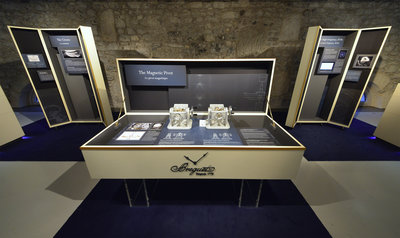VENICE, Italy – Today’s luxury business is in a state of upheaval, but for investors, the market is ripe with opportunity.
At the Financial Times Business of Luxury Summit on May 22, a panel of executives from banks and investment firms across Europe spoke about the luxury business from the perspective of investors, in particular the importance of building a strong brand and audience. During their conversation with moderator Rachel Sanderson from the FT, the panel emphasized that young people are an incredibly lucrative market for luxury.
"The challenge that fashion and luxury brands have is to concentrate on their DNA and their own strategy," said Elio Milantoni, partner and head of M&A advisory for Deloitte. "Capture the millennials who will make up 40 percent of the global market in the next seven years."
Peak growth
For luxury brands, there are multiple parts to running their business that each require unqiue skills and foresight.
During the panel, the discussion turned to how brands can grow from a respectable mid-sized luxury brand to a company that is truly global.
To achieve this, though, many luxury brands require outside assistance.
"To oversimplify, if you have a great product and you understand and can capture the trends of the moment, you can probably build a $100 million business, but if you want a $1 billion business, you need a number of things that those some young entrepreneurs are not the best at," said Marco De Benedetti, managing director of The Carlyle Group and co-head of Carlyle Europe Partners. "Sometimes the mentality of those entrepreneurs is a little bit of a control freak type.
"Often they are not good at attracting talent in that organization," he said. "We can be a helpful partner and we can help build the organization and attract the right talent."

Growth is high among luxury brands. Image credit: Credit Suisse
The panel also discussed the current state of the luxury business.
Overall, growth is high and investors feel confident in luxury as a whole.
The panel agreed that luxury brands are good investments. The total luxury business is at around $500 billion total, which is the highest it has ever been.
Yet despite this upsurge, there are still many uncertainties for luxury brands to deal with.
"On the one one hand you'll never feel as good about business as today, but on the other there are huge challenges today," said Luigi de Vecchi, chairman of continental Europe for corporate and investment banking at Citigroup.
Social changes
Despite the questions that abound for the future of luxury, one constant is the disruptive effect digital and social media have had on the business.
There are a whole batch of new luxury startups that exist mainly online and on social media that have completely upended the way consumers, particularly valuable young consumers, shop for luxury goods.
For example, British fashion retailer Matchesfashion.com has unveiled a new interactive and curated guide called The Style Daily.

The Style Daily is Matchesfashion's new curated content feature. Image credit: Matchesfashion
The feature combines elements of chatbots, editorial content and online shopping into a unique stream of recommended products. Uniquely, the content provided by The Style Daily is available only through the retailer’s mobile application, emphasizing the primacy of mobile in the modern digital landscape (see story).
"There have been a number of brands that have emerged through social media—Lulu's, Fashion Nova—they are built on social media platforms," said Carrie Barber, managing director and head of global luxury, apparel and beauty at Credit Suisse. "The market hasn’t had an opportunity to evaluate that yet, and so I do think it’s a hard question to answer how the market is going to value it.
"But it's hard to argue when you have some cases businesses with 8 million followers and great revenue and they’re doing really well."
{"ct":"xclUIkPBIwcvkRTF5V8gTgyzg3A3et\/iAmdff03GEbKMToGWTzEyWeQsnAB2ayVRAdYUCAlvSHG5A79SV6xd9SvnKo\/WqUSFP\/VAOo6i86n\/eEGYX3FXmzbUosfiscN5H6jqFgR69VWRWhCNXt539aZovUmTWEGTbrtiWLfRibgGzHltiXM0PrJkJJDcywJ0HDQEgRt79k7MGsoKj+rf8GnmbxpyQNfwG5f4nwoSeSNVW3B7LPPJ2ciVzjK1dkHPQQaiyqFwyrlx4g3fGtrJqfH0P5fA\/OpD\/iANhcmi8NiBPDR7yC1Cojf3F6JqgTTRrD6RcGfxRJ32fpS70lS8pcNn00S7rayos2j0CJv71ZwQVs\/zhfzQzFxBT7Ug6gjRt01gIylbwBX7QBwphekoDzrky2I\/zJG9m4YxuLZnNX++qQygHay0zh14WZqCBwHsRrDYyJWxPbFN4Tpjk+tPwT0Lv2FrwHksuZvyShekKW2iOWgYvt576WMqVYgjoyHve9+V5oXOgegZfOLPDd\/WUJJI2jW7UyzLol6B\/dTCXBG1TDkPfmfd509y2w8KSeRhNWVQKHfAitsBYOvvPMLUwu+ko9AD38Uu3SD0eIeIIdw8bEb5l0qu3feAU8TXFvFrCBOWJ6qtE2hds4vBNyw77CcYccXiVZ6pTtjbqkXqb\/ZaqHu2GXHBkYj83wX2WhbN7U9AukR+eZmI1FVbexrhwsm49KAY\/KWoFTtXQWgc9Sm+ReK61vjZYfwJhDUk8EEjCtzQFZcupSDsRzQHYYjtMsbJ14PryNWyN90GCR79YHVexTq9\/D7AXQDZVO0Kv\/\/9cSu6AfnZ+c7SkN9QpSYs\/Ln7uLL0LrA5ya4OB7sXV6YLEmDSMroxYnyVxZ1VzY0oDuhoeaS3wV8NG5WpD792t08XW5b5w5ef8vv8vXqGq8HMA+47COyiEbLwvyEF5zxv+mpKLigaVFVwULIbamov9y0HJ8GFtheirE9qL6sCIHnL1JLdF1I7+bbx0km71++wr+lB6zVbNnNzZc3GS5ziJPTkmER4aS82VnAqc27RUHTN\/waKn1d5L4JfW1gbI9CTDR1hrlV6t+wbc\/13hsPo6lrDVxmwffHNaQUUuZmVmK1L8gqWhLDz3KmE31oIZlUNpygPZENWjtryNdxvzIVUWYwa9vWai+TPmmqFdPiPyrsFRwuyzNLBNIMnZzwA9ZcMQ91ytfIHWFi\/nmWoKYcrHK2uPfRynimHXlnPQATj8U4RE+uVDuY\/5uz1LVRq+VvL+eCqhxwel4H6ofI8\/1v1coSDpJbTyxxRd0trcZfckPDvh+9WYpwxH213Jfi79+z8MuDd3PRvRqn5MuFutTbtY2SujNmSv9BKmeKUyNcE4\/z8l8rh6CEA5Z2\/Hwr5Jf+bGxDfFPGy6MqZHPy4ErXgllpxsc800BjcR\/2BncZEmJPCIqq4pRAglPgam5YxZIp6HxjQPDgmqs0sF9WhpTYcvYifMQV64p6I\/z+qgclnxsEGr9er1bTYK7fgrG5C9yZ\/dDkcGc4Vv6DqJvvvcV5IHXYKM6ecSwxMipY4eK4FReVDzXiTdPKxoa7Fjz9GBw78I4WaoYWcXu1fLHjMUKhyPK+IsY2paL9o5tvXSNUkfb06ux9x9g\/D8k0eEYXDFhp0lZJRY25m5T+0NCikkOP7O\/Mn7NUUQyAcs47VE\/V6yvdI3OC\/ub1x0FWADBuqXLcqWHQitecZoG0FqWF8Z8s6GCZP10HZie8XJoLeYFvfPk\/vpPEPvp2faLflxNJ8FnMPJugTTiv6j8hENTbSj5BK+ZtbfSQvcguC0dDc+kurNNTCZK92clsKNmlwtQu6XAkP7K6wTYRaSgOfhdLifwpj8p7uiVfAebP4WVS4xBIo5QtU98yZWrH0igmWZzkgVLDB9ZhkHKwFzlYPAAKItFnkjZD8RqQX\/lARAzy3vRvyqRNMFTfUWWi9HnBOrogr9S7yC05Xwaaae0a5De7TAQEOyORv3oWCD3MSOan2x+zR+M4tzq0XGV9+EVJLVuHi0\/WMVNEAFDPt+mIalUmvSzISPhuR2h9iAEpTF8fG9eg5Nq3ltaB4QBKLBYThNbX9cdoKV3XB8fel3vKiwyW5A3a854iei72JDcssZoGj++UO7gQ7cB2nWarDPdemteD\/OP\/6TmxEn2JOtuLXBcq1kegWtP2adAe5wtzVi3RQjFJ2vfIknOMUsIytBSYtmVsgfS07qxAJGdrWU8p3ZADFWW7WEjdbkaWUgsuKlNNqJO8ORFsd9izh3X9xEsAEkk4FYyCKylBwLnTGLeV4CHlA3j9zw8e\/Aa8TLBUR\/82nPTr6Gm6aW7jRVNDW4epQZJV0x4Ka+knvYrpIF4jiLTJXj+49V+api0hNdNw4T4pvr+in1p6x0UkG3uqX8V7dw6qYBhOCoThZC8IofFPzdtW6yOkGmyTi+wRd02C3mM\/2hxE0J\/Fwq8x5oEGJuK5CzKy7wZ+egZcd8\/3Y8WXtwOnXz834WVw47wWN+XSyhP7zwJP3\/hlVtQkNtrhqJ8vg5wVdFirQaZFV6Qw+BaIV\/ZHy+SAX7lFMdMeiLFRnpldHGCX82C\/7muYLoymQC\/f\/MHXwWjBInOhDXa+Gu\/boFVSPJgcvAQEZdmiEKdFcea5+Im1ph83VLdvkJpojlOo8Ab4qXvLdgalcrH4Kbp3hgAOV7s2aiDydRKFbetFpDqPYsDLl4IjElVLcAJz4HttfnnGi9xoTuVmo8HZxlNZPMoenL7iS+ePN6VIx4GvP1geUUqWx8kRXhXPPs\/0dBwd\/d8t9A6Ew0tpPhf2HNwQbZ8zYSDRlyuH0u7Nla5tN75ACrpR2l6Pi86jiJn9qQNqUsQ7mb6WnUgHI3OrBtZI5wA6t25gQfr4N6CJTVpr3TjjOTuBfGjV6stm90ITTaBY4wMDHwwGvBtRHEI0ho5BxuMfgccHoiA0oTxOBQ\/TUJw1ONF1DgkE7wNhrNUgMTGpvkBeNtANj+A85kmST1XVrvaHh8xkj03a+VYAN0m7vd8allEH3kPvS\/7fwLzBRQSIVKMBMA5ql1S084qRjb1HWgEQKmjqIMq2f7NH8zZ6s5L0BzGcvxvAJERp8DqrH9dMtJHh476CVO7h4CJjHitpqBjjxXcltuQokazYJAzdov9nj+M8+q3TVXa59Vb4aZl4R17FRhLUrAMKs\/7qD4nInsA1NexCG\/8VIIjLRtMI\/voQCG9k++oBxse\/rJkKvHSShRRZEQhTuw73gUmRw5zVJyqhux2ym3ZzycxjzyWor98rTq3FQlaxc\/YzoHBdHGWbP8\/UYgJFrBy0K+Pzo+fj7wLP08PXNKkFDwQt0TwkOBJ9\/MWF0a8mZSKPAe8NryCmStQ42aTwPHfvEVwG2QVB5ISuIzGGs1URg9LETHP5LBKBOdSYyZF8FjLDsPwpZBwB7Ux4Cu+LF3p4wNxo0fVrO6s\/Jb19F0a0j3tSp\/AwfJFhH9cPXUKDKNqRD+SBP\/+zb2x8hWZjwnSPYZY5t3SW3oJO5RU55cz2n\/liMJ98YGiY6K84JzXDiwPZ\/Z1LuFDIaAxyEggQYM+OaZo33O\/YZZhABI51xXewx4QHwkIz2rkNfNzn3+rjZnkDj3oUXwqTw+5R1h3DZ3jT1\/NZmF0CuTRO1KIOqF1a7BRmM1+F1sFeqQTOYb36otEgHsSvAn7leKxtLAawrZz2C7HuvbVYFC3vg7DiPIUwKdjsI\/3JqZWAJWlasXfUUiATkwQqkA45LrbqFEobJSypkmJIoOY9sz3Fzzf00DBiEpRBERwL25qWrbZBfEMkhNR0lRdeniWko0plawNsMwPR2Jmavo6x9LBaLkUP\/SWkorlYHD\/Qq5hpyhakRMBZsOubec+5n3tQJGgAVZnPJlTgPoaDzjn38JtHyW8iIoWNxx0k5G94PBxOxl2u6bSi7GlAtSihVbHJJOFK67bVH8A20OXRs\/G2i9d4XDvgbef9Ap7U\/JBV1eBjUdkCPdN8+tESKlpLV5Kg7LTLhfz\/rlBj\/cp+I6nDBH1ZONRwbiH45ij7ZE1lrsDehBSUskITqeXZSy0PfkUXP73YWwi9DW38558JemMzeTYW3t6Jhj3wm4Tqy29wA3Lv+v9a3RN65Q2eeOBQ8TuN1zoRr4mFI8s1osh+0LrdZyz6AATS3+BM2C+irYlRuI0n8vVJ7gLtn5Dcu9cummH2L9w6rx80HjLxSlET1zzmk+MhDq8qN4fioeudkTsRzc0B0lQ0\/gf2Hxjt4VS3myydWXkFPWTnQDN7uGdtzCbaEAP0cGKQp9LrwTrmzkCbnlO\/UEVNEifhhx590m4KBbkjllBb0knV7c7lhYP029Sa\/Pq7NiSWBBYeOO9ElEFWEDXyKlFj0njf2ALEZlmDD58YZnq7\/AXi5MvqFVj+ONVrWhwsqmJSKRdTa8sqaG++BEMhETmht3k3jrWJ7qHD6l814tprmr1VOq2B3ylDt0\/cZcU7KgKY5h7nyBjyCXEt6UVCqiU2y0Y8\/DwnBVGeqj\/PR\/4aini10+rn9tawqvnKkchp1CVIcS\/f1uVg4G1L6edLLPJMDVxXoHyXxUt7VbXu5RiXkHg0yn0Jdgbap5Wj6vEV\/f1FZg4IrK8XV3OaQCjiXc+rqC9WvzCXJvI3JGq0m06tz+2azTw\/fVGGkZQl0KK\/G2smeRRGbyjL+JFhtFcbEXMaFuOjMSyr1Q65u7U8Tq8c9ZrVWOhr2NRn5CAgCzrxvTur6rkZV\/qe+SgbjkmiN6o1loVaAu+K1JBsxmY5zqdrSZxxFIW0fVWftMA2KtWACgNVFo6hm+DphPoMB2CVEEZPg1q5J3I\/jb\/FSPzFqMp8Nk5ZaDEpTJqLUbAU16TRvUMxujSOM1ydj56AFL6ytlBk2pL\/6u1QKbdhxb8AsHblzLZ3nkTgYB5thBZ3+De94QvtkqbP0ZP2zBTlKmzHp7DuZ44eqgHycAcxQBRVuCjY+hXsurb0LmgHi+IufFkBfsU6YnvMeLBA5QIuXQ\/wIoJtUgs4wl6VHjfPGoQcAXh7KBI1hbwtXVmq9Euaug9dZNl+RpbqojQ38HHSccV5mxk0XXeV1JacQIhSs9DLhw0mdtlvbX+MsnnirCcA9w2mz8KPSgSK7puRGc9HxM8FbnEww8CWbmAT\/zMU6emd1w7V2ak0LebV0CAk55OBKake7+dz6jS0Zg35TgILExE73J7UDq7kebjaPfjJ86k1ev26IFjnr4EkMJILJFQMLAcH\/\/fxMyDNbmighaxOur+NEKhmT6Rh7vu7O4xvAmlhcFrQD8F87LlpB2WtX0rxdgV0QS\/PZ1Fj3yH\/LvpeWkCei3jIvjsavQBMHdO\/am5AY4eH2t24\/t13\/b729rDMET2ePBT+uJtj+bQ8AwQuB0ckDMf7GX3dwXSRqrglbr+INuKFsNuzGcLZDmxxKZ0jh0hE2qOgL8VE2G\/w4QHOPxhbUIIDY4gaWZDfv9FNHljGqEY5C0k3kjGp3kBImDxPVmFTFmiGllXxWEXgWvQ90+5\/XLCefX9THhRXiC3uIXnFTdOzpQvCjcjym74C\/t2H8Dy0fw+yYtLVa5rf6Sj6Vdr8\/XCCSrubhqTF0AW9bfLTKhU4neOInr3UD7LXu71mylVMreN2EreKEqwlJxnJoqEftSSCXI+Rvtk1\/PVlvOh4bpE5xuVPB8bHUwclPaRhGGjpGTFfPbX6+wwYgmSvxDG8ciz7ivLCjhJEFQqcO2TlIvbkDVHWKOSx3S3bFd+QYwDoEMZXxNeWsMHL+ncC10vkGVHEe8vpqeTALcQNDXNWOrRIQH54UkXimR+k383QugsGmiXtpsr6t1ZESJcvEJeq2iWWC87nRSacxgBapaN03IDBRRrHxqHUMqdUDgzpe2yIjJ7zFHVbaXkO3gCZxWqVvOEr4c4mchgWJjNaMqnT0kpCbOQB5aRCFbk1FsiVkTPjj7OmEer\/GrHAwK1GB\/bsK2+\/K3rddi\/Giz9tKitWnnBp7u+oba71Z8pxl6cuvB28\/WlSGKOoCZ3xpStPH1XTx\/D6wI0a2aZzmBS326NRX9HXqeRkY3AEUN0fAyswwFcQZo+njhNbRvhXZhInRQACO\/Ipls2ItTyBVQxvyy7tfgfc+mtm04QuCp5gCBc1TFKQWDBwvH4d3aniNwJye4WRKgCROruznhRR1pakqt3FqGnkoRXDeDs+AG8Mw0lQrA17EgRRw4hwpUHKzQonH9vKlUcDnhIu2M4L48Ul6ZX31cv1BwHfgm7Dsru\/ZObi3BDBaFO26UEJc\/VU8QSSltZuJ+UTN1jYpNH3zwSjquAJeBSew5NKRTDXcyq\/C+3qCYNPnF13aiBe8OkZehLxlv7uXbmPDwZ4nCix1SQkzBWe+nwdhNhsN3qOIE83aWBGp4QKwFTtBjEz5OneMxrqeAlGiyTrKJ2l0LKISVcmgqb2a3iXx1gippRnbbHJ7SubIVdTBRrfXl8o2iV8Y6ETDPuOjydswaEfVrq1iwr7dLahPE98+l3mD9+tGUwgBwBPU0Bl7fDBna1h0Narw9iSzfk1RONUQfbzGr4QzxgrJ505JTn7VWE7whElMXy7LpfS4dAHxjm7scuDndxsiDf6e7R8cISFzcp2TrFpI0sTKxDsB5Hep03nvIgpjipTfaDAnGWqiV4fTmDJEzbmzW7O7qPNi\/lGZv+IIMKj\/etfuIYSzUpXX54lexYdzwKVzRDPOSsZlpO+8bXyKW2\/J+SRXpHbP7BOs2az3rrBw2x6Ttz1PmrNb7jqlnXxfSAOCMhsPBSIAPq1rfOmorwyzO\/qeaOEjxh4J9TuOCC8G2Kmipa4mQ5FjLGnY7geVtG83QvRV5VT6FNFoQnYBAcpvQaiVPqvqMLwU8pYrXh4gxGJobQ1RTScxSmZsoiN0RGKwRbkJ8IoNCKm+QFTf1SMjaqs6F2I2vdx+FJL396pQlW+6i40F5utbr9usCu8Gt3CboINik0w0WcaQLogRUKkn03caYItZsc7wXmfuw4XqexO1I6f9J6SYsZb15W3GfCpp9w4mrSdHbVZNa1d5eKCEXFmk3D9cfVwvfnL3kJ6cHl66p1fbtpqgoR6Ep163SvA\/nRR6GupJ4uMDRDu86w58pM5zEAG6OUZUj1nPN0cgCu15QNqGxq0+ssrnBR0hCIYWhLmqfXTKqRq5Tw==","iv":"4234e4fea41bf4ac965726d4ece05021","s":"71d4de637508a89f"}

 Social media has upended much of luxury marketing. Image credit: Deloitte
Social media has upended much of luxury marketing. Image credit: Deloitte